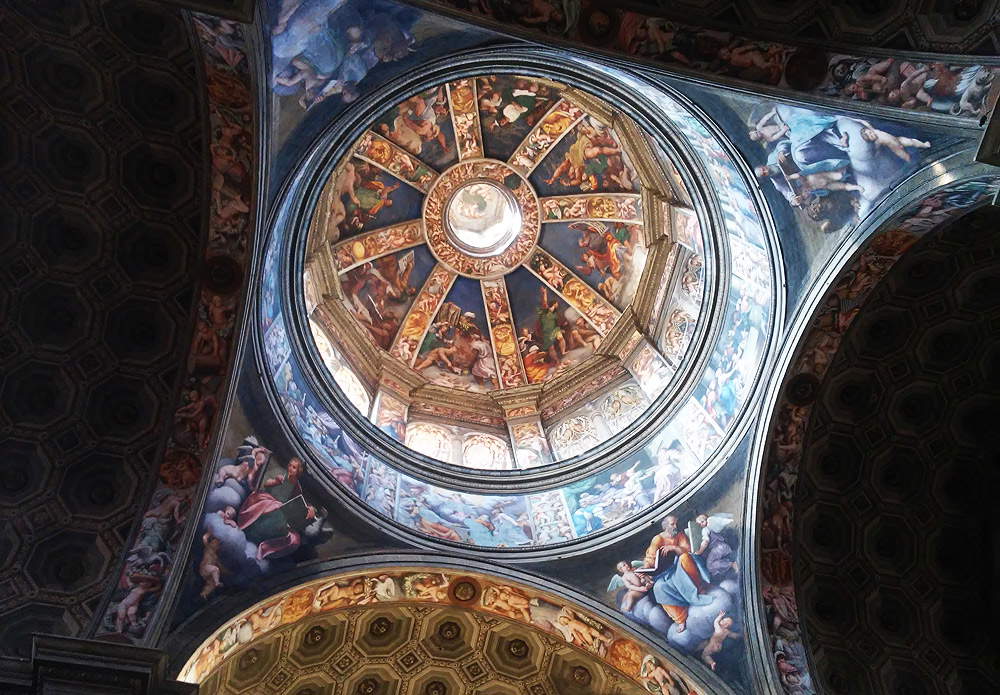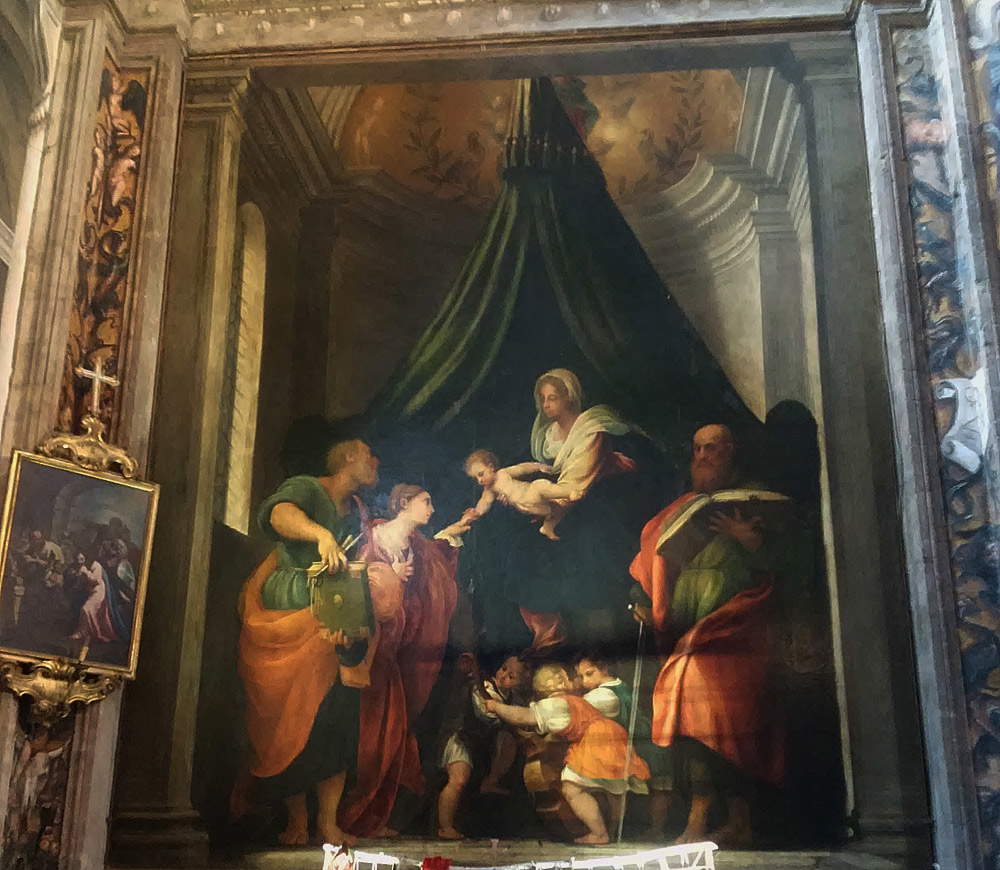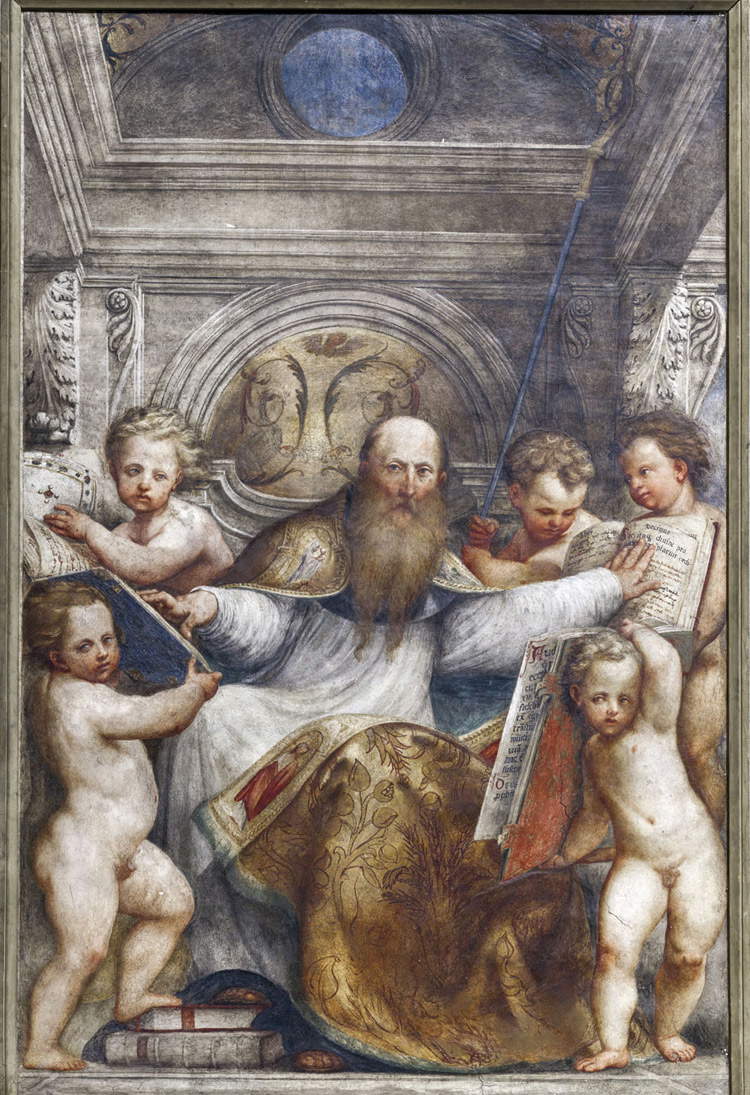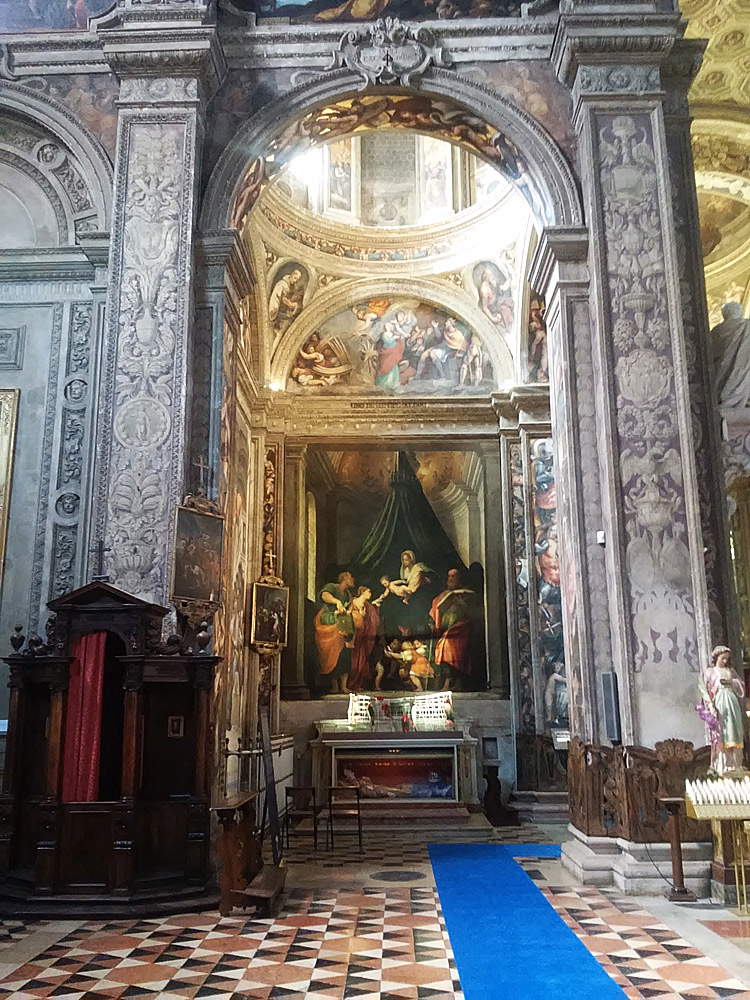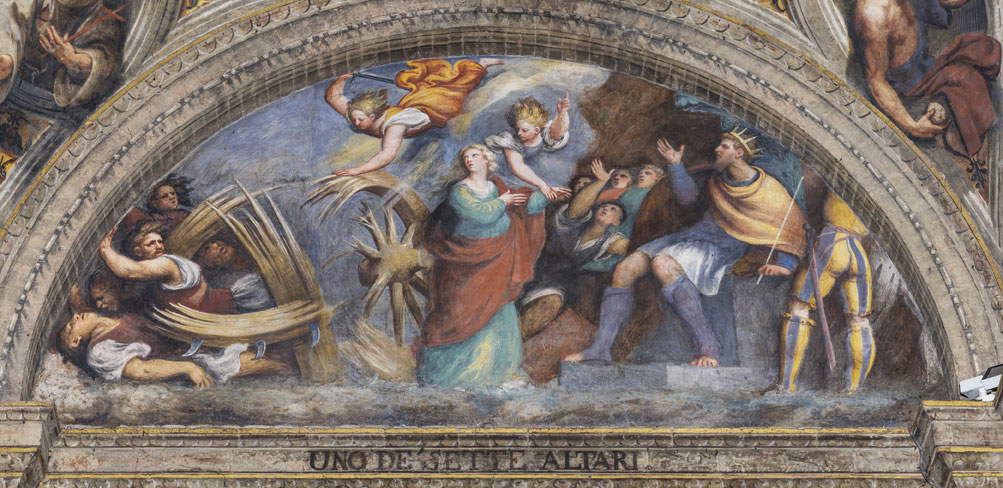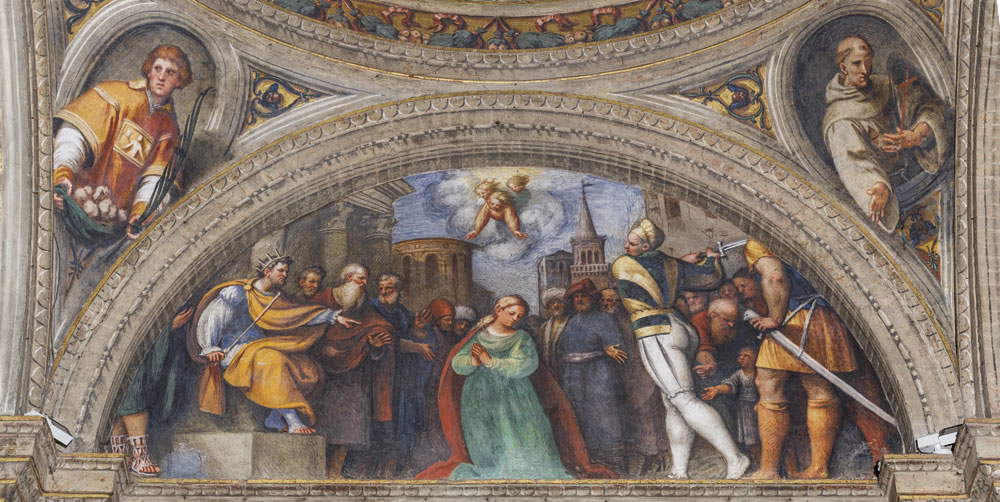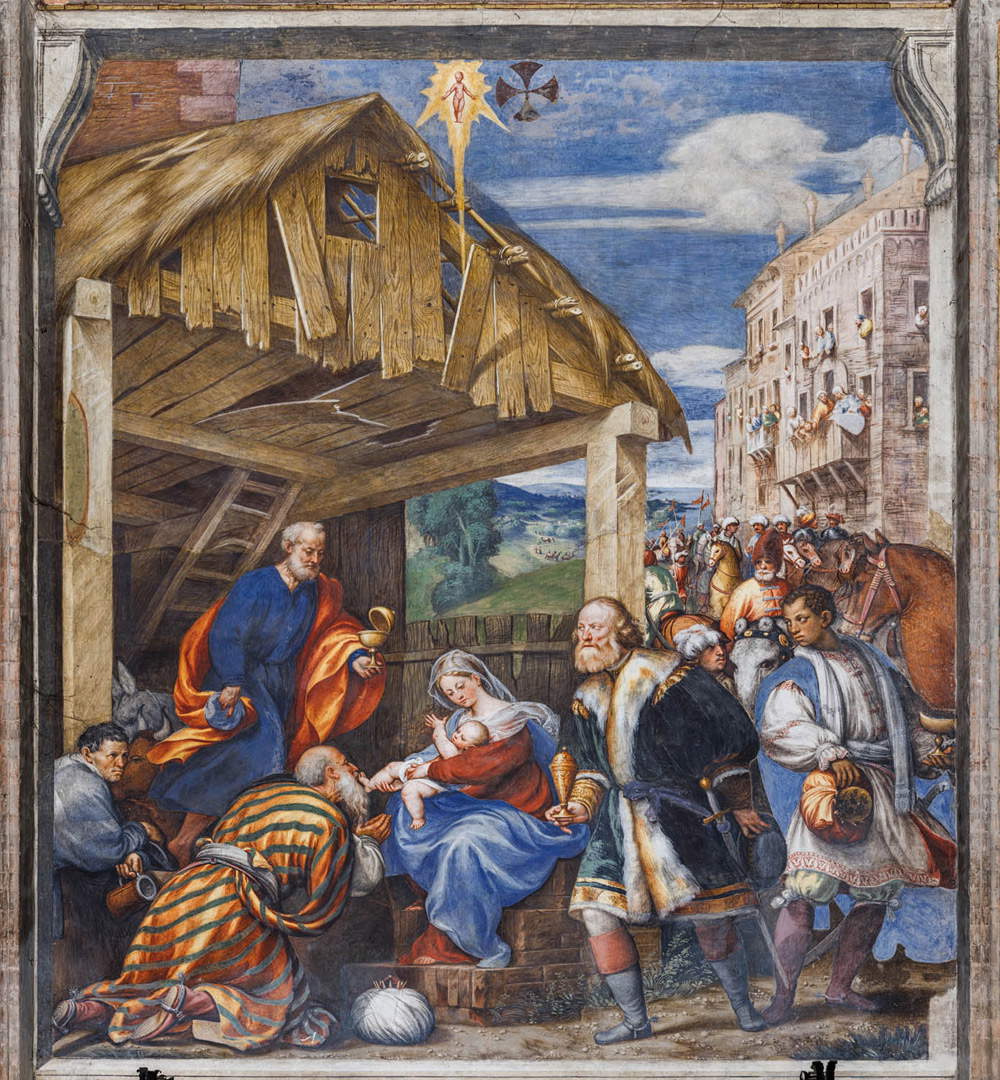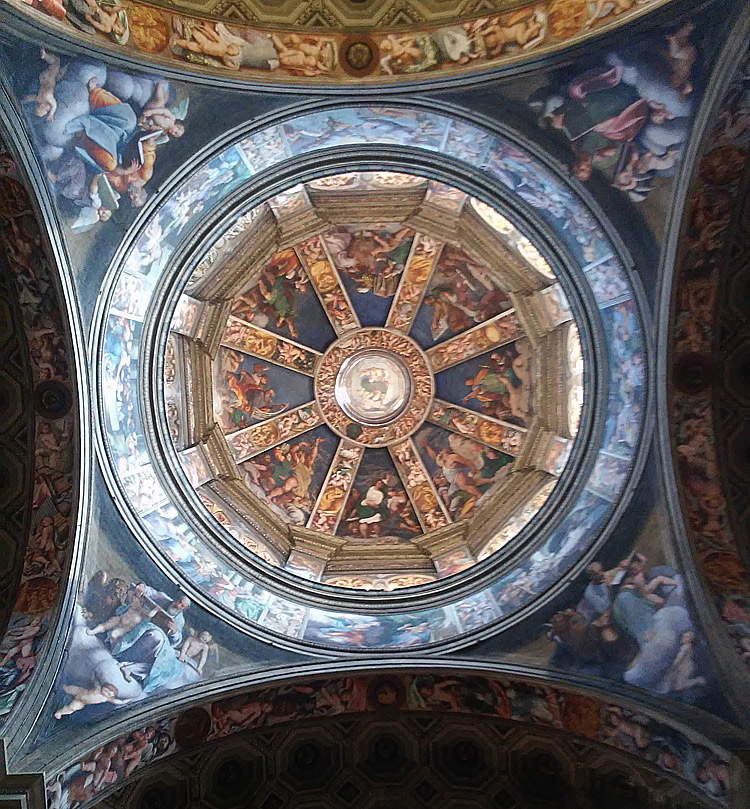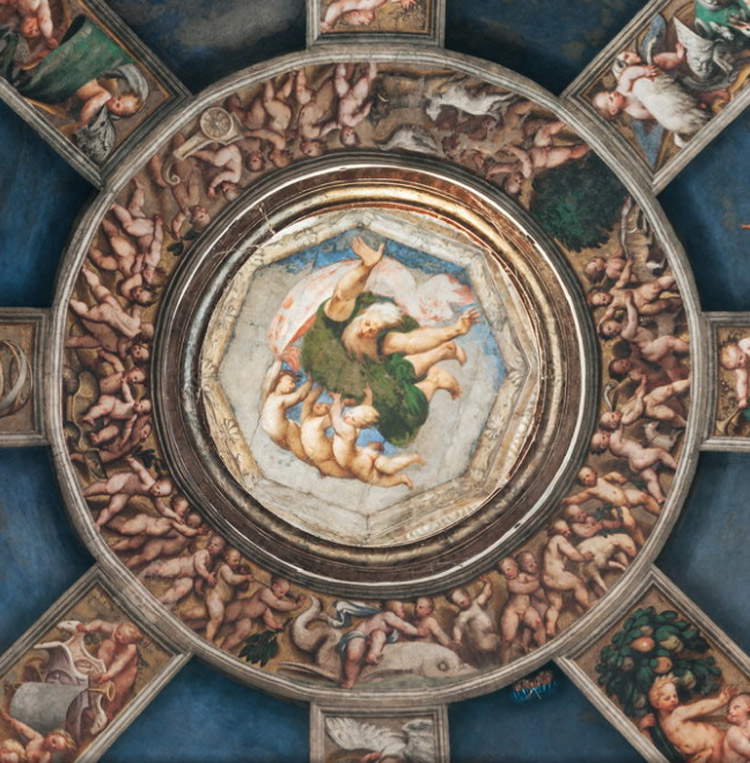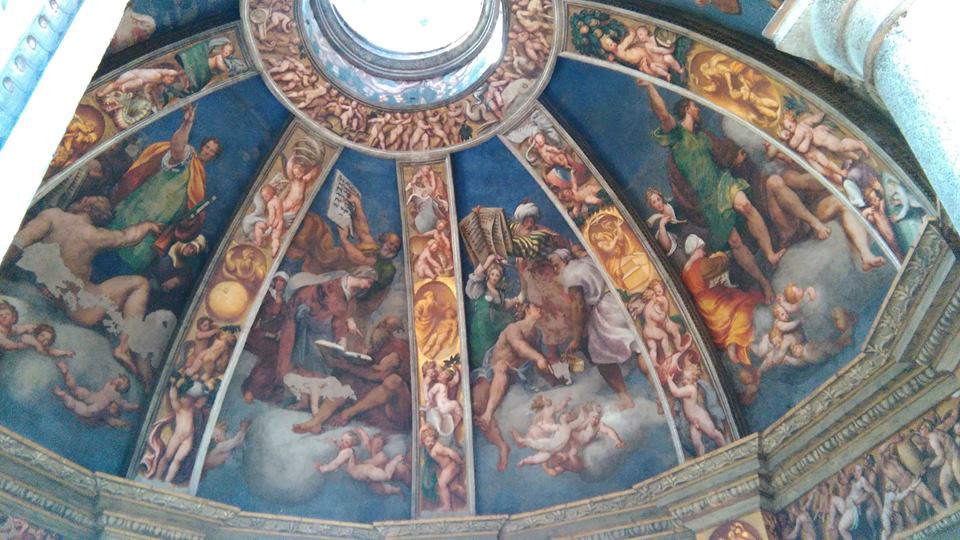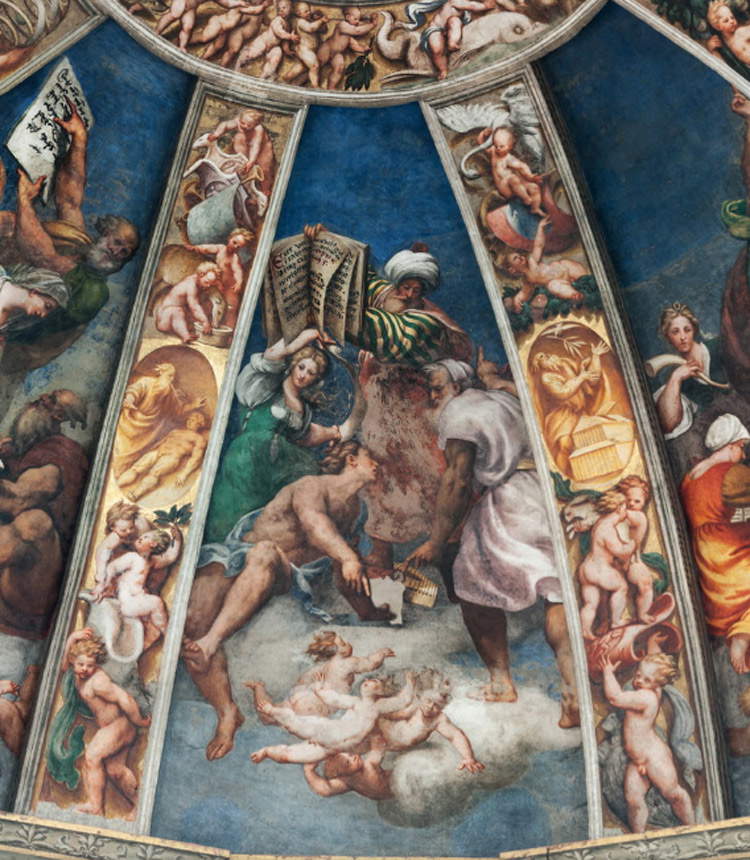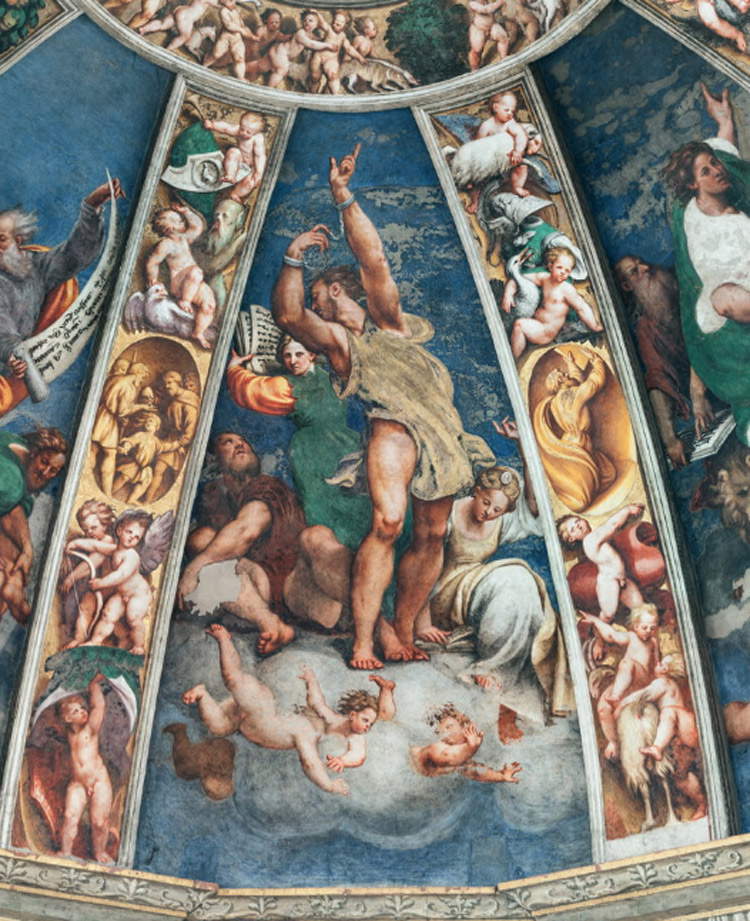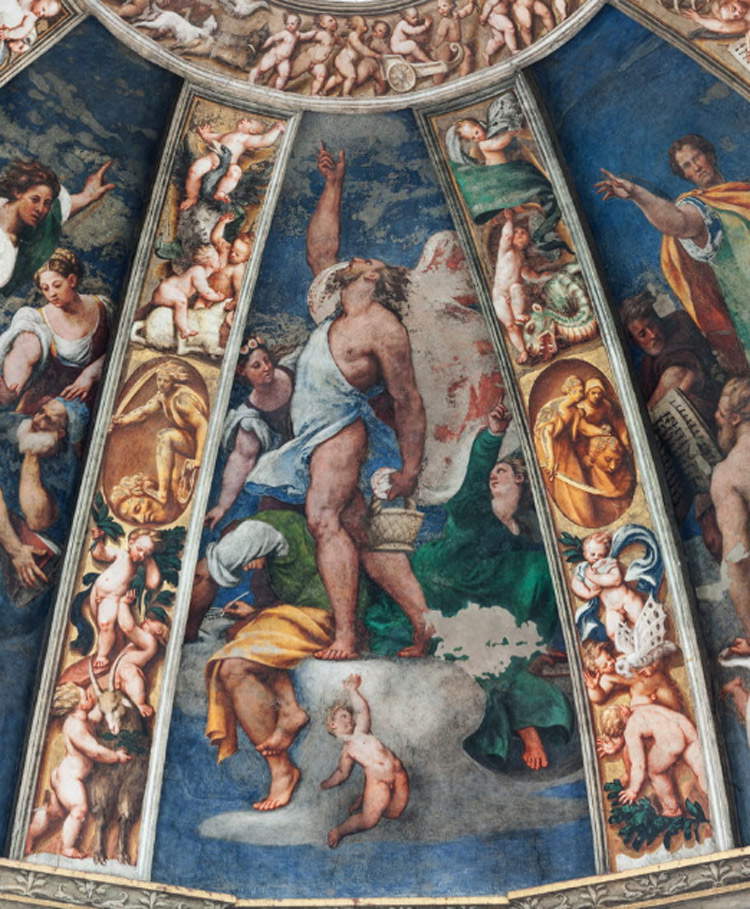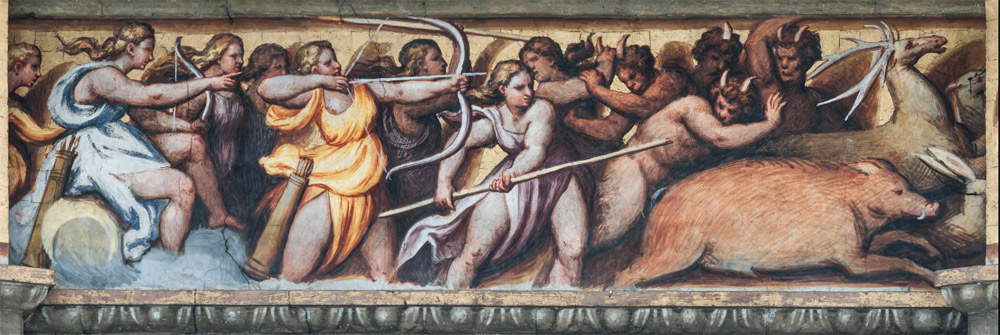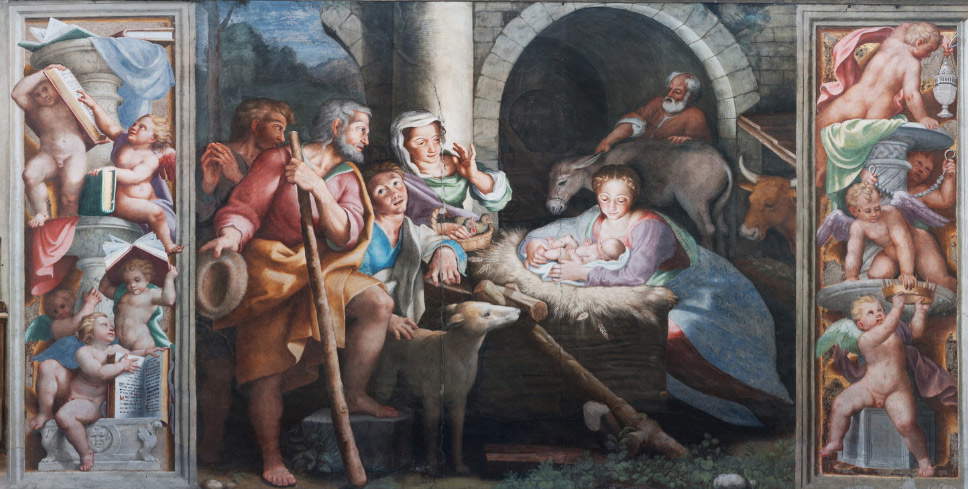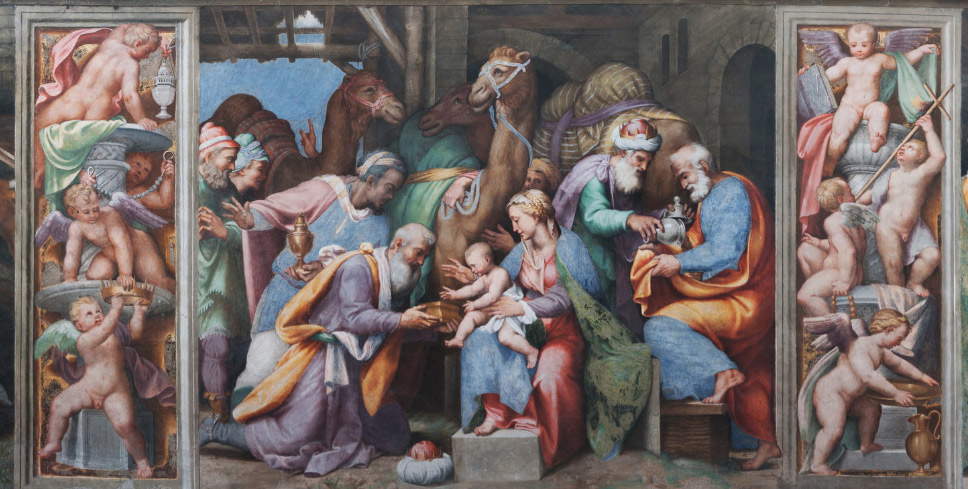by Ilaria Baratta , published on 13/05/2018
Categories: Works and artists
- Quaderni di viaggio / Disclaimer
Pordenone's fresco cycle decorating the dome of the basilica of Santa Maria di Campagna in Piacenza is one of the great masterpieces of the 16th century and is considered the Sistine Chapel of the Friulian painter. An account of the frescoes after a visit 'at altitude'.
Our Lady of the Countryside is the Vatican or rather Pordenone’s Sistine Chapel: so claimed François Rio, a French writer and art critic active in the 19th century and author of De l’art chrétien (1841). Rio was referring to the basilica of Santa Maria di Campagna, a church on the outskirts of the city of Piacenza whose history goes back as far as the year 1000, rebuilt in the 16th century and frescoed and decorated beginning in 1529, the year after the architectural site was completed, by painters and sculptors of great renown. One among them was Pordenone, or Giovanni Antonio de’ Sacchis, who was born between 1483 and 1484 in the city of Pordenone and died suddenly in Ferrara, at the age of 56, on January 14, 1539, while a guest at an inn; the sudden death led art historian and admirer Giuseppe Fiocco to think of poisoning.
The Friulian artist, whose entry into the arts was probably due to his father, who was a magister murarius (a kind of master mason) by trade, had been called to the church of Santa Maria di Campagna in 1530 to paint a series of frescoes and an altarpiece: the latter being the Mystical Marriage of St. Catherine between St. Peter and St. Paul, in which Pordenone had self-portrayed himself in the face of St. Paul, while for the face of the Madonna he had made a portrait of his wife, a beautiful Piacenza gentlewoman, of the Dal Pozzo family, and by whom he had had five children. The frescoes in question would instead be those that still decorate the basilica’s main dome and which, until June 10, 2018, thanks to the opening to the public of the so-called Artists’ Walk, can be admired up close by making the Ascent to Pordenone.
 |
| Piacenza, the facade of the basilica of Santa Maria di Campagna |
 |
| Giovanni Antonio de’ Sacchis called the Pordenone, frescoes in the Basilica of Santa Maria di Campagna (1530-1535; frescoes; Piacenza, Basilica di Santa Maria di Campagna) |
 |
| Giovanni Antonio de’ Sacchis called the Pordenone, Mystical Marriage of Saint Catherine (1530-1532; oil on panel; Piacenza, Basilica of Santa Maria di Campagna) |
As a trial essay, Pordenone had done the Saint Augustine, a fresco that the Fabbricieri liked so much that, wrote Carlo Ridolfi in his Maraviglie dell’arte (a collection of biographies of illustrious Venetian painters), they wanted him to follow to paint the following two chapels and the main gallery, the Chapel of the Nativity, commissioned by the Piacenza patrician Pier Antonio Rollieri, and the Chapel of St. Catherine, commissioned by Caterina Scotti and dedicated to St. Catherine of Alexandria. In the Nativity Chapel, the painter had depicted theAssumption in the lantern, on the walls episodes from Christ’s childhood, such as the Adoration of theMagi, theAdoration of the Shepherds and the Flight into Egypt, and the Nativity of the Virgin. In the Chapel of St. Catherine, two episodes from the life of the saint: the Martyrdom of the cogwheel and the Beheading of St. Catherine, the Dispute of St. Catherine in which he had portrayed the architect Alessio Tramello, the designer who rebuilt the basilica in the sixteenth century, and the altarpiece with the Mystic Wedding, which we mentioned earlier.
 |
| Giovanni Antonio de’ Sacchis known as Pordenone, Saint Augustine (c. 1530; fresco torn out and transferred to fiberglass support; Piacenza, Basilica di Santa Maria di Campagna) |
 |
| The chapel of St. Catherine in the basilica of Santa Maria di Campagna in Piacenza |
 |
| Giovanni Antonio de’ Sacchis called the Pordenone, Dispute of Saint Catherine (c. 1531-1532; fresco; Piacenza, Basilica of Santa Maria di Campagna) |
 |
| Giovanni Antonio de’ Sacchis called the Pordenone, Martyrdom of Saint Catherine (c. 1531-1532; fresco; Piacenza, Basilica of Santa Maria di Campagna) |
 |
| Giovanni Antonio de’ Sacchis called the Pordenone, Beheading of Saint Catherine (c. 1531-1532; fresco; Piacenza, Basilica of Santa Maria di Campagna) |
 |
| Giovanni Antonio de’ Sacchis called the Pordenone, Adoration of the Magi (c. 1531-1532; fresco; Piacenza, Basilica of Santa Maria di Campagna) |
Returning to Rio’s assertion, the frescoes decorating the main dome of Santa Maria di Campagna are likened to the frescoes of the Sistine Chapel, as Pordenone is compared to Michelangelo. Both, according to Giorgio Vasari, possess strength and terribleness: in the first edition of the 1550 edition of Lives, Pordenone, in particular, is praised for his strength, terribleness, and relief in painting, a trait also highlighted in the later 1568 edition, in which his ability to counterfeit foreshortenings and render plasticity to figures is emphasized. Pordenone’s art is characterized, according to Vasari, by terribilità et un certo furore molto da pittor nuovo e stravagante così da essere considerato nella pittura così valoroso, che le sue pitture appariscon tonde , et spiccate dal muro. There wherefore for having given strength, terribleness et relief in painting, he places himself among those who have done augmentation to art, et benefizio to the universal. Greatest endowment, which gave those who do not intend great annoyance because it does not reach the intellect to the depth of such difficulty, possessed by Pordenone was that of realizing foreshortenings for which the measures were adapted to the visual perception of the viewer, an ability also typical of Michelangelo.
Thus Giovan Paolo Lomazzo had defined this ability, pointing as an example to the God the Father of Santa Maria di Campagna, prima vista mentita suprema particolare: to represent in piccioli spazj the figures from below upwards in the perpendicular vaults, making us see the parts below in a certain way perfect, and so also those from above. But those that are at length for the most part are escorted in such a manner, that this such figure proves to be wider than high, and operates within this wonder, which makes it seem to us great, as if it really were so. If the viewer lifts his gaze to the lantern of the main dome, he will be struck by the extraordinary nature of the decoration: the God the Father accompanied by cherubs supporting him seems to hover lightly as he oversees what is beneath him. Paola Ceschi Lavagetto pointed out that the precedent of the Eternal Father in the dome of Santa Maria di Campagna is Michelangelo’s in the Sistine Chapel.
 |
| View of the dome of Santa Maria di Campagna from below |
 |
| Lantern fresco: God the Father |
And in earlier times, even Fabio Di Maniago, in the Storia delle Belle Arti friulane (1842), had likened Pordenone to Michelangelo, stating that if among the famous painters one wanted to make parallels [ ] I believe, better to compare Pordenone as with Michelangelo Buonarroti. That if it should seem too strange to some, that I should compare him to one of the most celebrated artists who ever flourished, let me use as an excuse Michelangelo himself, who, if Ridolfi is right, had such esteem for his talents, and so much judged his works to be in conformity with his own, that, hearing a Curtius painted by it extolled, he left Florence, and took himself to Venice expressly to admire it, and finding it far superior to what fame told, departed from it showering it with supreme praise.
Di Maniago had added further that they both owed their art to themselves and not to their masters, for they formed their own and original style, that they both refused to depict nature in its simplicity, but wanted to face it by seeking all the difficulties of art in order to have the glory of overcoming them. Both, endowed with fervid imagination and lively wits, wanted to vent their sublime concepts in the vast fields of the walls, badly suffering from being restricted within the confines of short canvases. Both of them had the good fortune to live in the most beautiful epoch, which the arts boast, they figured in the two cities that were its principal seats, Venice and Rome, and rivals they were and emulous of the two greatest painters who flourished then, Michelangelo of Raphael, and Pordenone of Titian. Known in fact was the rivalry between Giovanni Antonio de’ Sacchis and Vecellio, mentioned several times in the two editions of Vasari’s Lives and recalled by Francesco Sansovino, who had stated that Pordenone was in painting of such a lively spirit et di tanta inventione , that he made Titian so excellent afraid several times. And Luigi Lanzi, author of theStoria pittorica della Italia (1795-1796), had declared that to have competed with Titian is no small thing to say for his glory, and assures him at least the rank of second in a time so fertile with excellent artists.
Returning to Di Maniago, he had written that both of them, Pordenone and Michelangelo, as favorite subjects of their brushes chose the Sibyls, the Prophets, and that terrible day, on which the Son of God descends to judge mortals. Indeed, if we think of the vault of the Sistine Chapel and the main dome of Santa Maria di Campagna, both Sibyls and Prophets are present in both: to these figures Pordenone dedicated the sails of the dome, while Michelangelo placed them at the sides of the stories, in the spaces delimited by the corner sails and spandrels. Moreover, the former depicted Sibyls and Prophets together in each sail, while the latter separated them, leaving only one figure in each dedicated space.
 |
| View of the dome frescoed by Pordenone |
 |
| The structure of the dome |
 |
| The sails of the dome |
The dome of Santa Maria di Campagna has a sail-like structure: there is no impression of upward motion, as the actual space is intended for the invasion of the figures themselves. Each scene depicted occupies a specially created space. We understand this very well when we reach the end of the Ascent to the Pordenone, when with extreme astonishment and wonder we find ourselves at a privileged height to admire the frescoes of the dome up close: those small figures that we used to see from inside the basilica with our eyes upward, we now find them so close that we can peer into their details. Unfortunately, for security reasons, it is not possible to go all the way around the dome in order to see all the scenes depicted: however, the overview turns out to be quite wide.
Different scenes open up before our eyes: in one sail are depicted on a cloud supported by cherubs two prophets and the sibyls Eritrea and Phrygia, one of whom in the center points to a prophet who listens attentively to her the book held by the same prophet, while the other shows above a written page by pointing to it with a finger as if to make the viewer read what is written. In the next sail appears the prophet David with prophets and a sibyl: here again we see the presence of books, the written pages of which are facing the viewer; in the other next to it are depicted prophets with the Delphic s ibyl and another sibyl: here a prophet dressed in green standing in the center of the scene turns his gaze toward a nearby prophet and raises one arm upward, while one sibyl reads and the other holds a cornucopia in her hands. This is followed by another sail depicting a prophet and the sibyl Cimmeria: she holds a book and turns her gaze toward him, he holds a long scroll. And again: Samson with the Persian sibyl and another sibyl, while next to the sail depicting two prophets and the sibyls Erythrea and Phrygia, another sail depicts two prophets, the sibyl Ellespontica and Jonah: here a figure in a green robe and an orange stole holds a closed book in one hand, while he raises his other arm forward and his gaze is stern; in front of him sits a completely naked and muscular man, who is holding on to the cloud below him and turns his gaze away. Remaining hidden from view are the sail with Daniel, the lion, two prophets and a sibyl, and the sail depicting Habakkuk, standing upright with his gaze upward and one arm pointing upward.
 |
| Prophets of the sails: David |
 |
| Prophets of the sails: Samson |
 |
| Prophets of the sails: Daniel |
 |
| Prophets of the sails: Habakkuk |
All the characters in the sails are supported by clouds, Raphael-inspired, and it is clearly visible how the main character is disproportionate to the secondary figures, shrunken down to give the viewer a sense of the depth of space and the deception of foreshortening according to a viewpoint from below. Each sail is divided from the other by pilasters characterized by the presence of putti with animals, plants, musical instruments and objects and a monochrome oval in the center, in which a scene from the Old Testament is depicted: the Creation of the World and the Creation of Adam,Noah’s Ark, the Sacrifice of Isaac, Joseph sold by his brothers, Moses receiving the tablets of the Law, David with the head of Goliath, and Judith and Holofernes are all recognizable. Towering above the sails is the lantern of the dome in which God the Father is depicted, and a crown of cherubs who seem to be kneaded with flesh, and are shown with puerile attitudes, and uninhibited, in accordance with the custom that baffles them, as Luigi Scaramuccia has written. The God the Father of Santa Maria di Campagna is also reminiscent of the panel in the vault of the Sistine Chapel depicting the Separation of the Earth from the Waters: here, too, God is depicted in flight looking downward accompanied by cherubs supporting him.
Another point in common between the frescoes of the basilica of Piacenza and the frescoes of the Sistine Chapel is the intention and the ability to combine Christian religion and classical mythology in the iconographic programs: Michelangelo depicts scenes from the Old Testament in the center of the vault of the famous Chapel, in the lunettes the ancestors of Jesus, and on the sides of the stories he depicts prophets prophets and Sibyls, the latter belonging to the classical tradition. Pordenone, as mentioned above, depicts in the sails of the dome of the Piacenza basilica figures of prophets and Sibyls alternating with Old Testament episodes in the monochrome oval medallions in the pilasters, while in the frieze connecting the dome and the drum episodes from the mythological tradition alternate with episodes from the classical tradition. Among them we recognize Bacchus inebriated, Silenus inebriated among the satyrs, the Rape of Europa, Neptune and Amphitrite, Venus and Adonis, Diana and the nymphs fight the satyrs, Jupiter strikes down the Giants, the Labors of Hercules, and again the Supplication of the Sabine Women, Castor and Pollux at the Battle of Lake Regillus, the Justice of Trajan, the Battle of Cinegyrus, a Warrior at the Tomb of Achilles. The mythological episodes that follow one another horizontally have been interpreted by Jacqueline Biscontin as a succession of triumphs of good over evil, according to a reinterpretation in a Christian key, while for the monochrome medallions she has identified the source in the Decades of Titus Livy and passages from the Dictorum et factorum memorabilium libri of Valerius Maximus, in addition to the Old Testament source.
 |
| Scenes from the frieze: Bacchus inebriated |
 |
| Scenes from the frieze: Venus and Adonis |
 |
| Scenes from the frieze: Europa |
 |
| Scenes from the frieze: Diana |
 |
| Scenes from the frieze: Jupiter |
 |
| Scenes from the frieze: the Labors of Hercules |
However, the iconographic program of the dome of Santa Maria di Campagna has remained unclear to this day, as the direct link between certain subjects has not been discovered to provide a unified key. The hypothesis of St. Augustine’s De Civitate Dei, a saint we find depicted inside the basilica, to the left of the entrance, in a dedicated painting made by Pordenone himself, has been put forward. As Valeria Poli argues, the iconographic program could be summarized by St. Augustine and St. George, the two figures depicted on either side of the entrance: the former, as mentioned, by Pordenone and the latter by Bernardino Gatti known as Sojaro. These two figures represent the two souls of the church: the triumphant and the militant, respectively. If so, it could be a reference to an iconographic program indicated by Monsignor Paolo Giovio, who in the Stanza della Segnatura in the Vatican identified the search for the True, the Good and the Beautiful through Law, Art, Faith and Philosophy. It remains an open question, however.
In any case, Sojaro did not only create the St. George to the right of the entrance to Santa Maria di Campagna; rather, it fell to him from 1543 to complete the cycle of frescoes in the dome, completing the Apostles in the pilasters of the drum, the Stories of the Virgin in the drum and the Four Evangelists in the pendentives. A parallel could be built with another church decorated in fresco by Pordenone: the Church of the Annunziata in Cortemaggiore, particularly the Chapel of the Conception. In this chapel the artist depicted God the Father, accompanied by cherubs, entrusting the prophets and the Sibyls with the announcement of Christ’s advent; here prophetic figures appear in lunettes with capital lettering.
 |
| View of the drum from above |
 |
| Scenes from the drum: Stories of the Virgin, the Annunciation |
 |
| Scenes from the drum: Stories of the Virgin, the Nativity |
 |
| Scenes from the drum: Stories of the Virgin, the Adoration of the Magi |
 |
| Drum scenes: Stories of the Virgin, the Assumption |
To enable visitors to reach the unique spectacle of the frescoes in the main dome of Santa Maria di Campagna and to face the Ascent to the Pordenone quite easily, the so-called Artists’ Walkway was restored, thanks to the Bank of Piacenza and under instructions from the Regional Superintendent of Architectural Heritage, the so-called Artists’ Walk, the route that was taken by painters, sculptors, students from academies and art institutes, as well as students from the Gazzola Art Institute of Piacenza, to peer, admire and study the Pordenone frescoes at altitude. In fact, many inscriptions with the names that the students themselves had imprinted along the walkway are still visible today.
An exciting path that starts from the sacristy and, after a long series of steps, during which the feeling of suspense increases proportionally, makes us reach with much satisfaction the summit, the highest point from which it is possible to interact with those extraordinary works of art created centuries ago by two great artists of the time. One can perceive the play of colors, the perspective composition of the figures, that deception of the foreshortening so perfect that characterizes the Pordenone. Along the way, inside the choir, a multimedia screen has been set up that, through a very in-depth video, prepares the viewer for the visit with biographical information about the artist and with information about what he is going to admire after a few minutes.
Upon reaching the loggia of the dome drum, the highest point of the ascent, in addition to enjoying the artistic beauty of the frescoes, so close together, it is possible to look out over the panorama of the city: from here one can see Palazzo Farnese, Palazzo Gotico and the angel of the Duomo. You are then ready to retrace the entire artists’ walk backwards, but this time with a feeling of well-being and inner spirituality and with spectacular images in your eyes that will remain etched in your memory for a long time.
The Ascent to Pordenone is accompanied by a catalog with detailed images of the frescoes painted by Pordenone not only in the basilica of Santa Maria di Campagna but also in Cortemaggiore and Cremona to provide an illustrative comparison of his masterpieces. The essays present contribute to the complete knowledge of the artist: Laura Bonfanti has composed an excursus on Pordenone’s biographical and artistic events, Valeria Poli has outlined the critical studies on the artist, many of which have compared him to Michelangelo, Pordenone’s pictorial enterprises in Cremona, Cortemaggiore and Piacenza, and the history of the basilica of Santa Maria di Campagna. In addition, the catalog is enriched by the anthology of the painter’s biographies: the documentary texts related to his life and works. A unique initiative to make one of Piacenza’s most spectacular masterpieces discovered and known from an unusual perspective.
Warning: the translation into English of the original Italian article was created using automatic tools.
We undertake to review all articles, but we do not guarantee the total absence of inaccuracies in the translation due to the program. You can
find the original by clicking on the ITA button. If you find any mistake,please contact us.

